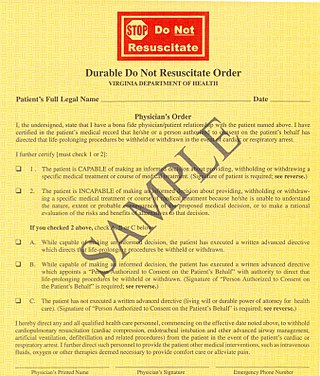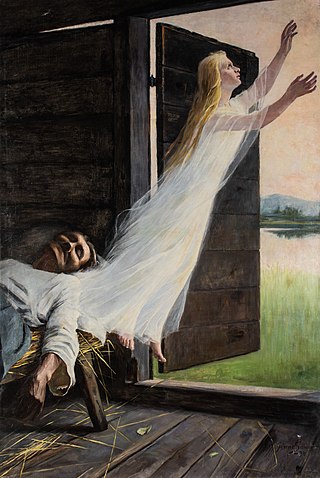Related Research Articles

Cardiac arrest is when the heart suddenly and unexpectedly stops beating. When the heart stops beating, blood cannot properly circulate around the body and the blood flow to the brain and other organs is decreased. When the brain does not receive enough blood, this can cause a person to lose consciousness and brain cells can start to die due to lack of oxygen. Coma and persistent vegetative state may result from cardiac arrest. Cardiac arrest is also identified by a lack of central pulses and abnormal or absent breathing.

Cardiopulmonary resuscitation (CPR) is an emergency procedure consisting of chest compressions often combined with artificial ventilation, or mouth to mouth in an effort to manually preserve intact brain function until further measures are taken to restore spontaneous blood circulation and breathing in a person who is in cardiac arrest. It is recommended for those who are unresponsive with no breathing or abnormal breathing, for example, agonal respirations.
Clinical death is the medical term for cessation of blood circulation and breathing, the two criteria necessary to sustain the lives of human beings and of many other organisms. It occurs when the heart stops beating in a regular rhythm, a condition called cardiac arrest. The term is also sometimes used in resuscitation research.

An out-of-body experience is a phenomenon in which a person perceives the world as if from a location outside their physical body. An OBE is a form of autoscopy, although this term is more commonly used to refer to the pathological condition of seeing a second self, or doppelgänger.

Advanced cardiac life support, advanced cardiovascular life support (ACLS) refers to a set of clinical guidelines established by the American Heart Association (AHA) for the urgent and emergent treatment of life-threatening cardiovascular conditions that will cause or have caused cardiac arrest, using advanced medical procedures, medications, and techniques. ACLS expands on Basic Life Support (BLS) by adding recommendations on additional medication and advanced procedure use to the CPR guidelines that are fundamental and efficacious in BLS. ACLS is practiced by advanced medical providers including physicians, some nurses and paramedics; these providers are usually required to hold certifications in ACLS care.

A do-not-resuscitate order (DNR), also known as Do Not Attempt Resuscitation (DNAR), Do Not Attempt Cardiopulmonary Resuscitation (DNACPR), no code or allow natural death, is a medical order, written or oral depending on the jurisdiction, indicating that a person should not receive cardiopulmonary resuscitation (CPR) if that person's heart stops beating. Sometimes these decisions and the relevant documents also encompass decisions around other critical or life-prolonging medical interventions. The legal status and processes surrounding DNR orders vary in different polities. Most commonly, the order is placed by a physician based on a combination of medical judgement and patient involvement.
Precordial thump is a medical procedure used in the treatment of ventricular fibrillation or pulseless ventricular tachycardia under certain conditions. The procedure has a very low success rate, but may be used in those with witnessed, monitored onset of one of the "shockable" cardiac rhythms if a defibrillator is not immediately available. It should not delay cardiopulmonary resuscitation (CPR) and defibrillation, nor should it be used in those with unwitnessed out-of-hospital cardiac arrest.
Near-death studies is a field of psychology and psychiatry that studies the physiology, phenomenology and after-effects of the near-death experience (NDE). The field was originally associated with a distinct group of North American researchers that followed up on the initial work of Raymond Moody, and who later established the International Association for Near-Death Studies (IANDS) and the Journal of Near-Death Studies. Since then the field has expanded, and now includes contributions from a wide range of researchers and commentators worldwide. Research on near-death experiences is mainly limited to the disciplines of medicine, psychology and psychiatry.
Pulseless electrical activity (PEA) is a form of cardiac arrest in which the electrocardiogram shows a heart rhythm that should produce a pulse, but does not. Pulseless electrical activity is found initially in about 20% of out-of-hospital cardiac arrests and about 50% of in-hospital cardiac arrests.

Agonal respiration, gasping respiration, or agonal breathing is a distinct and abnormal pattern of breathing and brainstem reflex characterized by gasping labored breathing and is accompanied by strange vocalizations and myoclonus. Possible causes include cerebral ischemia, hypoxia, or anoxia. Agonal breathing is a severe medical sign requiring immediate medical attention, as the condition generally progresses to complete apnea and preludes death. The duration of agonal respiration can range from two breaths to several hours of labored breathing.
Pam Reynolds Lowery, from Atlanta, Georgia, was an American singer-songwriter. In 1991, at the age of 35, she stated that she had a near-death experience (NDE) during a brain operation performed by Robert F. Spetzler at the Barrow Neurological Institute in Phoenix, Arizona. Reynolds was under close medical monitoring during the entire operation. During part of the operation she had no brain-wave activity and no blood flowing in her brain, which rendered her clinically dead. She claimed to have made several observations during the procedure which medical personnel reported to be accurate.

A near-death experience (NDE) is a profound personal experience associated with death or impending death, which researchers describe as having similar characteristics. When positive, which the great majority are, such experiences may encompass a variety of sensations including detachment from the body, feelings of levitation, total serenity, security, warmth, joy, the experience of absolute dissolution, review of major life events, the presence of a light, and seeing dead relatives. When negative, such experiences may include sensations of anguish, distress, a void, devastation, and seeing hellish imagery.
Lazarus syndrome, also known as autoresuscitation after failed cardiopulmonary resuscitation, is the spontaneous return of a normal cardiac rhythm after failed attempts at resuscitation. It is also used to refer to the spontaneous return of cardiac activity after the patient has been pronounced dead. Its occurrence has been noted in medical literature at least 38 times since 1982. It takes its name from Lazarus who, according to the New Testament, was raised from the dead by Jesus.
Return of spontaneous circulation (ROSC) is the resumption of a sustained heart rhythm that perfuses the body after cardiac arrest. It is commonly associated with significant respiratory effort. Signs of return of spontaneous circulation include breathing, coughing, or movement and a palpable pulse or a measurable blood pressure. Someone is considered to have sustained return of spontaneous circulation when circulation persists and cardiopulmonary resuscitation has ceased for at least 20 consecutive minutes.
Peter Brooke Cadogan Fenwick was a British neuropsychiatrist and neurophysiologist who is known for his studies of epilepsy and end-of-life phenomena.
Sam Parnia is a British associate professor of medicine at the NYU Langone Medical Center, where he is also director of research into cardiopulmonary resuscitation. In the United Kingdom, he is director of the Human Consciousness Project at the University of Southampton. Parnia is known for his work on near-death experiences and cardiopulmonary resuscitation.
GoodSAM is a global emergency and volunteer service platform and associated community co-founded by Mark Wilson OBE, Ali Ghorbangholi OBE and Ali Haddad in 2013. It is used by ambulance, police, fire, government, charity and health services to improve immediate emergency management, largely through video enabling Instant-On-Scene video assessment and from the platform's ability to alert trusted responders to provide immediate help. It is also the platform used to deploy nearly 800,000 NHS Volunteers across the UK to support those isolating or suffering with Covid

Suction Assisted Laryngoscopy Airway Decontamination (SALAD) is incremental step-wise approach to the management of a massively contaminated airway.

The Lund University Cardiopulmonary Assist System (LUCAS) device provides mechanical chest compressions to patients in cardiac arrest. It is mostly used in emergency medicine as an alternative to manual CPR because it provides consistent compressions at a fixed rate through difficult transport conditions and eliminates the physical strain on the person performing CPR. The first generation of the LUCAS device was pneumatic, while the second and third generations are battery-operated.
Post-cardiac arrest syndrome (PCAS) is an inflammatory state of pathophysiology that can occur after a patient is resuscitated from a cardiac arrest. While in a state of cardiac arrest, the body experiences a unique state of global ischemia. This ischemia results in the accumulation of metabolic waste which instigate the production of inflammatory mediators. If return of spontaneous circulation (ROSC) is achieved after CPR, then circulation resumes, resulting in global reperfusion and the subsequent distribution of the ischemia products throughout the body. While PCAS has a unique cause and consequences, it can ultimately be thought of as type of global ischemia-reperfusion injury. The damage, and therefore prognosis, of PCAS generally depends on the length of the patient's ischemic period; therefore the severity of PCAS is not uniform across different patients.
References
- 1 2 3 4 5 Palchik, Guillermo (2009-07-17). "Conference Report: The Nour Foundation Georgetown University & Blackfriars Hall, Oxford University Symposium Series Technology, Neuroscience & the Nature of Being: Considerations of Meaning, Morality and Transcendence Part I: The Paradox of Neurotechnology 8 May 2009". Philosophy, Ethics, and Humanities in Medicine. 4 (1): 9. doi: 10.1186/1747-5341-4-9 . ISSN 1747-5341. PMC 2717997 . PMID 19615065.
- 1 2 3 "World's Largest-ever Study Of Near-Death Experiences". ScienceDaily. Retrieved 2024-12-06.
- ↑ "Press Conference on Opening of UN/NGO Symposium 'Beyond the Mind-Body Problem: New Paradigms in the Science of Consciousness". press.un.org. Retrieved 2024-12-06.
- ↑ Sam Parnia. Writers Directory. 2018, June 15.
- ↑ Holden, Constance (2008). "Random Samples". Science. 321 (5897): 1749–1749. ISSN 0036-8075.
- ↑ Stephey, M. J. (2008-09-18). "What Happens When We Die?". TIME. Retrieved 2024-12-06.
- 1 2 Agrillo, Christian. Near-Death Experience: Out-of-Body and Out-of-Brain? Review of General Psychology, 2011, Vol. 15, No. 1, 1–10
- 1 2 Bókkon, István; Mallick, Birendra N.; Tuszynski, Jack. Near death experiences: a multidisciplinary hypothesis. Frontiers in Human Neuroscience, September 2013, Volume7, Article 533 DOI: 10.3389/fnhum.2013.00533
- 1 2 "Psychology Today: Health, Help, Happiness + Find a Therapist". www.psychologytoday.com. Retrieved 2024-12-06.
- 1 2 3 Orlando, A. (2021). Death Defying. Discover, 42(6), 50–58.
- 1 2 Parnia, Sam; Spearpoint, Ken; Vos, Gabriele de; Fenwick, Peter; Goldberg, Diana; Yang, Jie; Zhu, Jiawen; Baker, Katie; Killingback, Hayley; McLean, Paula; Wood, Melanie; Zafari, A. Maziar; Dickert, Neal; Beisteiner, Roland; Sterz, Fritz (2014-12-01). "AWARE—AWAreness during REsuscitation—A prospective study". Resuscitation. 85 (12): 1799–1805. doi:10.1016/j.resuscitation.2014.09.004. ISSN 0300-9572. PMID 25301715.
- ↑ Engmann, Birk. Does research on near-death experiences fulfil the quality criteria of medical studies? Advanced Studies in Medical Sciences, Vol. 8, 2020, no. 1, 1 –7
- ↑ Olvera-Lopez, Edgardo; Varon, Joseph (2014-12-01). ""AWAREness during CPR: Be careful with what you say!"". Resuscitation. 85 (12): A5 –A6. doi:10.1016/j.resuscitation.2014.09.023. ISSN 0300-9572. PMID 24121090.
- ↑ Robb, Alice. The Scientists Studying Life After Death Are Not Total Frauds. The New Republic, October 8, 2014, www.newrepublic.com, retrieved January 3, 2023
- ↑ Tassell-Matamua, Natasha A. & Lindsay, Nicole (2016) “I’m not afraid to die”: the loss of the fear of death after a near-death experience, Mortality, 21:1, 71-87, DOI: 10.1080/13576275.2015.1043252
- ↑ Rice, DT, Nudell, NG, Habrat, DA, Smith, JE and Ernest, EV. CPR induced consciousness: sedation protocols for this special population. British Paramedic Journal 2016, vol. 1(2) 24–29
- ↑ Lichfield, Gideon. The Science of Near-Death Experiences. Empirically investigating brushes with the afterlife. The Atlantic, April 2015, www.theatlantic.com, retrieved January 9, 2023
- ↑ Parnia, Sam; Keshavarz, Tara; McMullin, Meghan; Williams, Tori (2019-11-19). "Abstract 387: Awareness and Cognitive Activity During Cardiac Arrest". Circulation. 140 (Suppl_2): A387 –A387. doi:10.1161/circ.140.suppl_2.387.